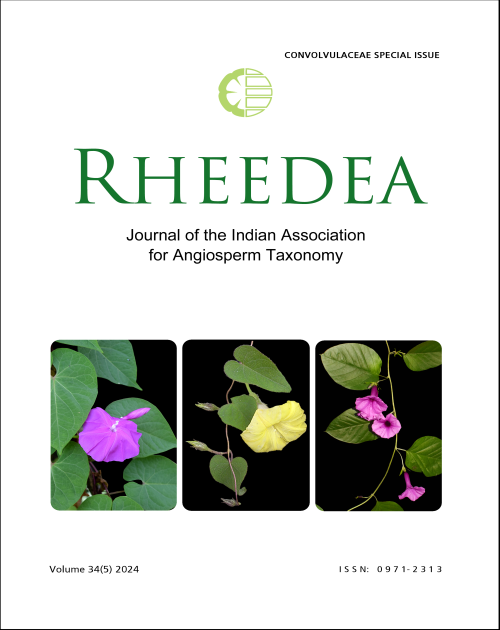Diversity of vascular variants and xylem structure across the Convolvulaceae and its systematic implications
Rajput K.S.*, Thacker K.D., Ramoliya D.G., Kapadane K.K., Shimpale V.B. & V.M. Raole
Published on : 31-Dec-2024
DOI : https://dx.doi.org/10.22244/rheedea.2024.34.05.03
DownloadAbstract
Convolvulaceae is the family of flowering plants that is popularly known as the morning glory family due to its beautiful flowers that open in the morning. The family is dominated by non-self-supporting, herbaceous vines, climbers, or woody lianas while erect growth forms are rare. Its members are widely distributed worldwide (both in tropics and temperate climates) and more often cultivated for various purposes such as the aesthetic importance of flowers, as a food crop and for folk/ traditional medicines. The present study characterizes several such anatomical traits that are ontogenetically unique or exclusively reported in Convolvulaceae, and if reported in other eudicots then the feature is rare. Along with common anatomical traits, the present study compiles several features that are extremely rare or hitherto unreported for any other eudicots. Some of them are unifacial and bifacial natures of the intraxylary cambium, formation of interxylary cambium, neo-formed (external) vascular cylinders, isolated xylem strands, perforated rays, radial sieve elements and formation of phloem wedges. Detailed ontogeny of vascular variants, stem anatomy, structure and composition of vascular elements is correlated with eco-physiology. These alterations are attributed to histological alterations towards the climbing habit to cope with narrow stems in cross sectional view, for fulfilling the demand vs. supply of water, minerals and photosynthate supply from source to sink. In conclusion, members of the family are well adapted to the climbing habit and various ecological conditions starting from aquatic habitat to pure desert conditions. Different members show all possible combinations of multiple vascular variants for the survival under various growth forms, biogeographic regions or extreme habitats like aquatic, water logging, rocky substratum, and xerophytic conditions. All these features may also have taxonomic implications, but not much anatomical data is available on the family because much of the diversity is still hidden in plants distributed in the tropics. As per recent trends, merging or separating the taxa exclusively based on molecular tool is a fashion that neglects the basic principles of plant biosystematics. Keywords: inter-and intraxylary phloem, interxylary cambium, external vascular cylinders, phloem wedges and sclerosed tyloses, successive cambia.
